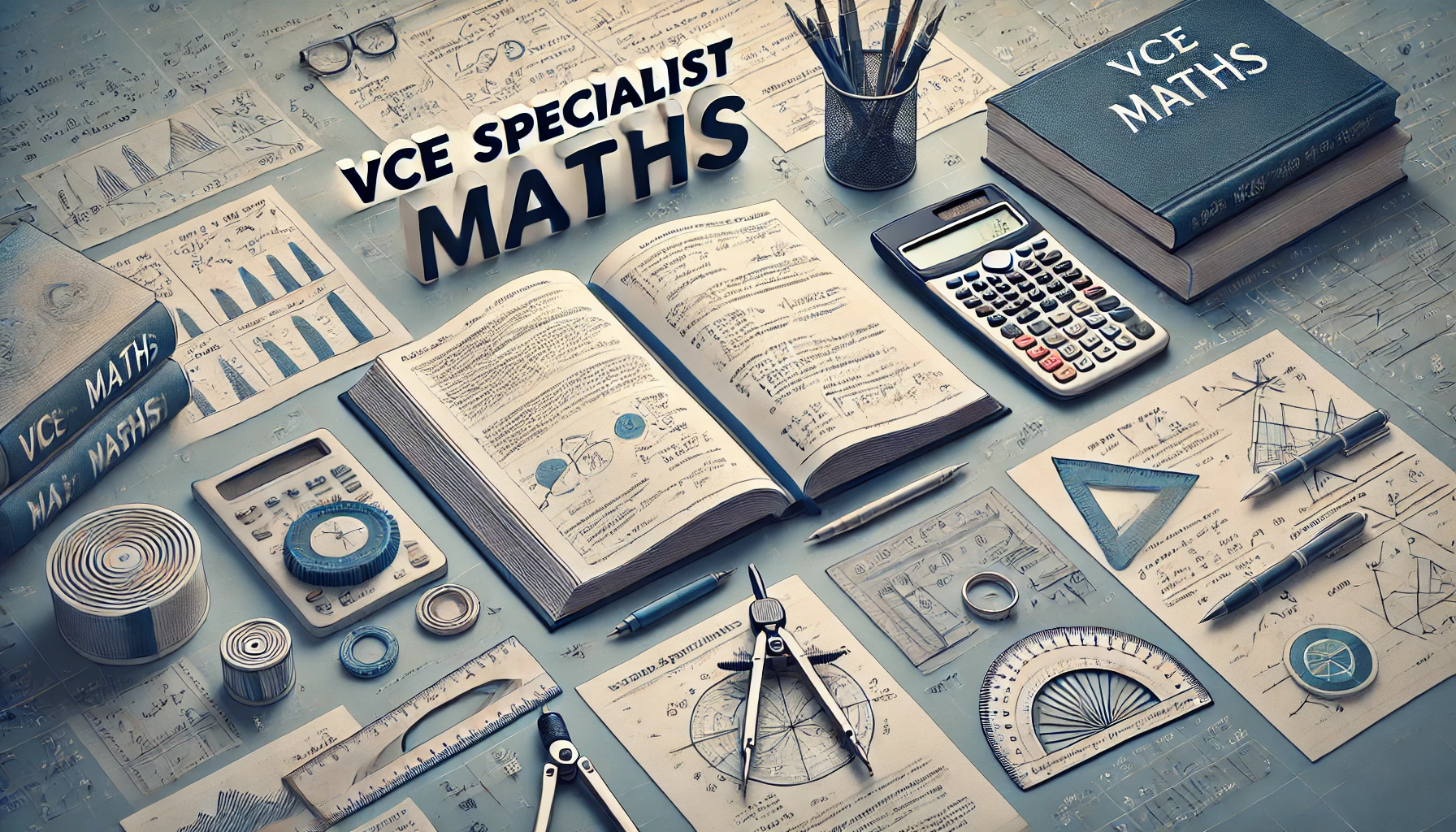
The VCE General Mathematics exam consists of two separate papers, each designed to assess different aspects of students’ mathematical knowledge and skills.
Paper 1 is a technology-free assessment, while Paper 2 allows the use of approved technology, such as calculators and software, to solve more complex problems. Below is a breakdown of the key differences between the two exams.
Comparison of Paper 1 and Paper 2
Key Differences in the Exams
- Paper 1 places emphasis on core mathematical knowledge and fluency in computations without technology. This includes algebra, data analysis, matrices, and financial mathematics in a structured, step-by-step format.
- Paper 2 integrates technology into problem-solving, requiring students to demonstrate proficiency in applying formulas, working with matrices, graphing functions, and analysing real-world data using tools like spreadsheets and calculators.
💡Exams are a super important part to any student's journey. Ace your exams with confidence following these 10 detailed tips!
Question Breakdown for VCE General Mathematics Examination 1
To help students better understand the structure of the VCE General Mathematics Examination 1, this section maps each question to its respective topic and subtopic from the syllabus. Additionally, it includes the distribution of marks, highlighting the areas where students performed well and where they faced challenges. This analysis can guide students in identifying key areas for improvement and better preparing for future exams.
The table below presents the mapping of questions to topics, along with the percentage of students who scored 0, 1, 2, or 3 marks.
VCE General Maths Exam 1 Analysis
Key Takeaways
- Strong Performance Areas: Students performed well in topics related to basic calculations, such as categorical variables and matrix multiplication, where the majority scored high marks.
- Common Challenges: Topics such as recursion, financial modelling, and transition matrices saw a higher percentage of students scoring 0 or 1 mark. These areas often involve multiple-step calculations or conceptual understanding, making them more challenging.
- Exam Strategy Implications: Students should focus on strengthening their problem-solving techniques for complex topics, such as shortest path algorithms and transition matrices, while reinforcing fundamental concepts like seasonal indices and median calculation.
💡Check out why past papers are the best way to study for exams!
Key takeaways from General Maths Examination 1 in 2024
Understanding the strengths and weaknesses demonstrated in the 2024 VCE General Mathematics Examination 1 is crucial for future students. This section highlights the key skills that should be prioritised, advice from the examiners, and common mistakes that impacted student performance.
Key Skills to Focus On
- Interpreting and applying statistical data – particularly in questions related to data analysis, where identifying the correct measures of central tendency and interpreting outliers were critical.
- Understanding financial modelling – including interest rate calculations and loan repayments, ensuring accuracy in multi-step processes.
- Performing accurate matrix operations – such as multiplication and transition matrix applications, where minor miscalculations led to incorrect conclusions.
- Applying network algorithms effectively – particularly in identifying the shortest path and Eulerian trails, which were challenging for many students.
- Using seasonal indices correctly – in time-series analysis to forecast trends accurately.
Advice to Students
- Carefully read each question to fully understand what is being asked before beginning calculations.
- Break down multi-step problems into smaller components to reduce errors and improve accuracy.
- Use calculators efficiently but do not over-rely on them—developing strong foundational skills is essential.
- Check answers against reasonable estimates to identify computational errors.
- Focus on conceptual understanding rather than simply memorising formulas, as this helps in applying knowledge to unfamiliar questions.
- Be particularly mindful of multi-step problems—these were identified as a common challenge, especially in Data Analysis (Questions 9 and 12), Financial Modelling (Questions 20, 23, and 24), Matrices (Questions 29, 31, and 32), and Networks (Questions 35, 37, 39, and 40).
- Carefully check calculations for questions requiring multiple options to be considered, as errors in these types of problems were frequently observed.
- Practise answering questions in a clear and structured way, ensuring that working and reasoning are shown logically.
💡Take notes efficiently and effectively using these tips!
Common Mistakes
- Misinterpretation of statistical data, particularly in determining the median and interquartile range.
- Errors in financial modelling calculations, especially in multi-step problems involving interest and loan repayments.
- Mistakes in matrix multiplication and transition matrices, leading to incorrect final answers.
- Misidentification of shortest paths and Eulerian trails in network-related problems, affecting problem-solving accuracy.
- Incorrect application of seasonal indices, resulting in flawed predictions and trend analyses.

Question Breakdown for VCE General Mathematics Examination 2
VCE General Mathematics Examination 2 assesses students' ability to apply mathematical concepts with the use of technology. This section presents a detailed mapping of each exam question to the corresponding topic and subtopic from the syllabus. Additionally, it includes the mark distribution, showing the percentage of students who scored 0, 1, 2, or 3 marks. Understanding these insights can help students identify key areas to focus on in their exam preparation.
The table below outlines the question breakdown along with performance statistics.
VCE General Maths Exam 2 Analysis
Key Takeaways
- Areas of Strength: Students performed well in median calculations and skewness identification within the data analysis section, with most candidates scoring high marks.
- Challenging Areas: Common difficulties arose in interpreting significant figures, recursion-based savings calculations, and critical path analysis, where a substantial number of students scored 0 or 1 mark.
- Exam Preparation Strategy: Strengthening understanding of financial modelling, recursion, and network algorithms can help students improve their performance in multi-step and application-based questions.
💡As students, we juggle assignments, exams, and more, often cramming last-minute. Let’s explore how effective habits can transform our academic journey!
Key takeaways from General Maths Examination 2 in 2024
To improve performance in the VCE General Mathematics Examination 2, it is essential to understand the specific skills required, take note of the examiner's advice, and be aware of common mistakes that students made in 2024. This section highlights these key aspects to help students refine their approach and achieve better results.
Key Skills to Focus On
- Interpreting statistical data accurately – particularly when working with percentiles, skewness, and regression data.
- Understanding financial modelling concepts – ensuring correct application of interest rate calculations and savings projections.
- Performing precise matrix operations – including multiplication and transition matrix applications.
- Applying network algorithms correctly – focusing on Hamiltonian paths, shortest paths, and critical path analysis.
- Following rounding instructions – ensuring that numbers are rounded only when explicitly required to do so.
- Avoiding transcription errors – particularly when copying values from CAS calculators into written responses.
Advice to Students
- Read questions carefully to ensure correct interpretation before beginning calculations. Misreading key details in multi-step problems can lead to incorrect answers.
- Check numerical answers for reasonableness to avoid errors in calculations, especially in multi-step financial modelling and network analysis problems.
- Follow rounding instructions strictly – rounding too early or incorrectly can lead to unnecessary loss of marks. Only round when explicitly required, as seen in Question 1e, where 85.7% was required instead of 86%.
- Use proper mathematical terminology – particularly in descriptive responses, where precise language is necessary. For example, in time series questions, qualitative features must match those defined in the syllabus.
- Ensure clarity in diagrams and graph markings – responses must be clearly presented as scanned images are used for assessment. Use a dark-coloured pen or 2B pencil and label diagrams precisely.
- Break down multi-step questions into logical components to minimise mistakes. This is particularly relevant for data analysis, recursion and financial modelling, matrices, and networks questions, which often require multiple steps or checking various options.
- Use a ruler for straight-line graphs – especially in data analysis questions where accurate plotting is necessary.
- Be precise when marking points on a grid – for example, in Question 3b, many students did not accurately place the point (1.9, 1.934), affecting their results.
- Only provide necessary information – extra, incorrect details in explanations can result in lost marks, as seen in Question 15b, where writing the delayed time incorrectly caused students to lose marks.
- Review final answers before submission – check that the question has been fully answered, the answer is reasonable, and that it aligns with any provided values in ‘show that’ questions.
💡Check out these scientifically proven strategies to improve how you study!
Common Mistakes
- Incorrect application of statistical concepts – particularly in identifying percentiles and interpreting regression data.
- Errors in financial modelling calculations – including failing to account for compounding when calculating interest.
- Inaccurate matrix operations – leading to incorrect answers in matrix multiplication and transition matrices.
- Misinterpretation of Hamiltonian paths and shortest paths – affecting problem-solving accuracy in network questions.
- Rounding errors – students rounded too early or incorrectly, leading to inaccurate final answers.
- Transcription errors from CAS calculations – resulting in incorrect final responses.

Conclusion
Success in the VCE General Mathematics exams requires a solid understanding of key mathematical concepts, strong problem-solving skills, and careful attention to detail.
To improve performance, future students should focus on mastering financial modelling, refining their statistical interpretation skills, and strengthening their problem-solving techniques in matrices and networks. Avoiding common pitfalls—such as premature rounding, misreading questions, and transcription errors—can make a significant difference in overall results.
Ultimately, success in VCE General Mathematics comes down to practising consistently, reading questions thoroughly, and developing a clear, structured approach to solving problems. With these strategies in mind, students can confidently approach their exams and achieve their best possible outcomes.







